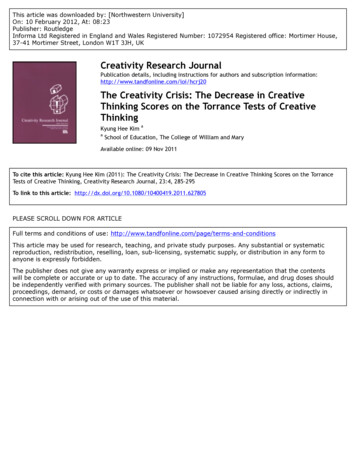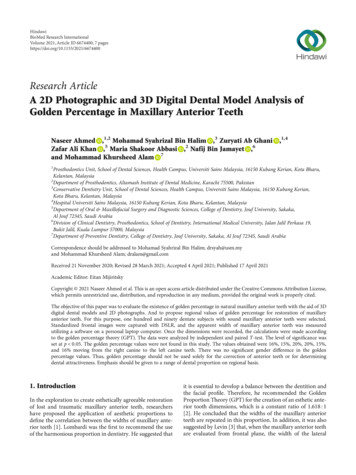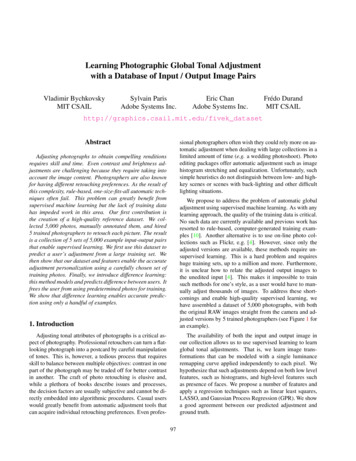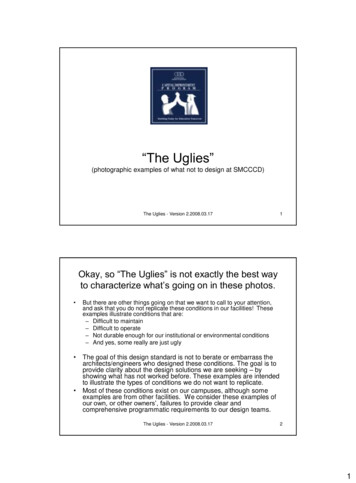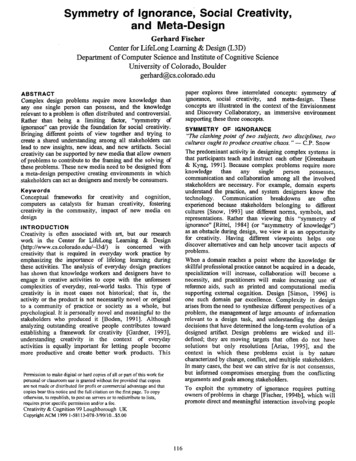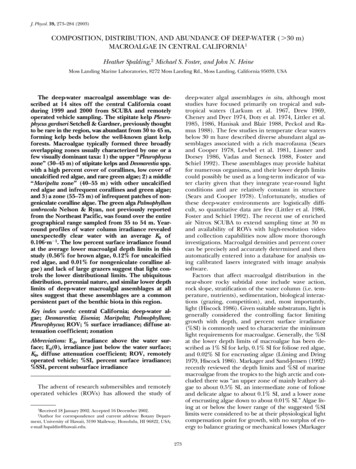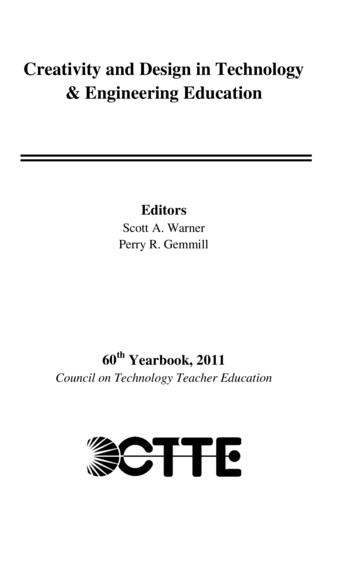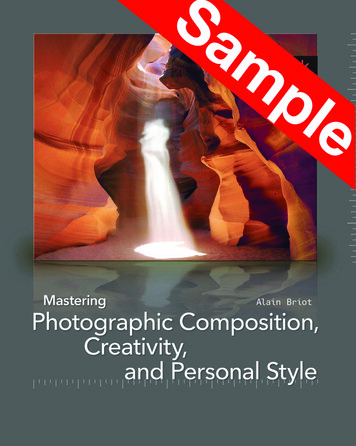
Transcription
Mastering Photographic Composition, Creativity, and Personal Style1692 Book Briot Composition.indb 124.11.09 19:42
1692 Book Briot Composition.indb 224.11.09 19:42
Mastering Photographic Composition,Creativity, and Personal StyleAlain Briot1692 Book Briot Composition.indb 324.11.09 19:42
Mastering Photographic Composition, Creativity, and Personal Styleby Alain Briot (www.beautiful-landscape.com)Editor: Gerhard RossbachCopyeditor: Tonya CrandallProduction Editor: Joan DixonProof Reader: Sarah CastellanosLayout and Type: Almute Kraus, www.exclam.deCover design: Helmut Kraus, www.exclam.deCover photos: Alain BriotPrinter: Tara TPS Co., Ltd. through Four Colour Print GroupPrinted in KoreaISBN 978-1-933952-22-21st Edition (2nd Printing, January 2010) 2009 Alain BriotRocky Nook, Inc.26 West Mission Street, Ste 3Santa Barbara, CA 93101-2432www.rockynook.comLibrary of Congress Cataloging-in-Publication DataBriot, Alain.Mastering photographic composition, creativity, and personal style / Alain Briot. -1st ed.p. cm.Includes bibliographical references.ISBN 978-1-933952-22-2 (alk. paper)1. Composition (Photography) I. Title.TR179.B75 2009771--dc222009003899Distributed by O’Reilly Media1005 Gravenstein Highway NorthSebastapool, CA 95472All product names and services identified throughout this book are trademarksor registered trademarks of their respective companies. They are used throughoutthis book in editorial fashion only. No such uses, or the use of any trade name, areintended to convey endorsement or other affiliation with the book. No part of thematerial protected by this copyright notice may be reproduced or utilized in any form,electronic or mechanical, including photocopying, recording, or by any informationstorage and retrieval system, without written permission of the copyright owner.While reasonable care has been exercised in the preparation of this book, the publisherand authors assume no responsibility for errors or omissions, or for damages resultingfrom the use of the information contained herein.This book is printed on acid-free paper.1692 00 Briot Composition Vorspann.indd 407.01.10 20:16
1692 Book Briot Composition.indb 524.11.09 19:42
Table of Contentsxiv Forewordxvi Preface12 About Composition3 Art, Facts, and Landscape Photography5 The Differences Between Composing Factual and ArtisticPhotographs6 Photography is Not DeadSection A: The Differences BetweenWhat We See and What the Camera Sees231692 Book Briot Composition.indb 612131313141518181921Learning to See Like a CameraOf Cameras and ArtGood Cameras Equal Good PhotographsA Matter of FiltersModifying What the Camera CapturesDifferences in Print QualityIt’s the Print, SillyI Should Have KnownThe Artist and His ToolsIt’s Only a Matter of Time222323233236The Eye and the CameraThe Difference Between Photography and RealityTwo Categories of DifferencesWhat the Camera Captures that the Eye Never SeesThe Soul of PhotographyConclusion24.11.09 19:43
Table of ContentsviiSection B: New Rules of Composition40414243476371100101Composing with LightEssential ElementsLight and CompositionFinding the Best LightFinding Sunrise and Sunset TimesUsing Natural LightChanging Light QualitySkill Enhancement 28137139Composing with ColorColor VisionThe Three Variables of ColorThe Munsell Color SystemControlling Color in PhotoshopColor BalanceColor PaletteSaturationColor Seeing AidesTaking Notes in the FieldComposing with Color: ExamplesSkills Enhancement 65Composing in Black and WhiteIntroductionBlack and White Is Color with One VariableSeeing the World without ColorBlack and White and ArtBlack and White and ManipulationColor vs. Black and WhiteSeeing in Black and WhiteExamples of Composing in Black and WhiteSkills Enhancement ExercisesConclusion1692 Book Briot Composition.indb 745624.11.09 19:43
viiiTable of Contents7166167167172174176178179183185Important Elements of a Strong CompositionIntroductionStrong Compositions ChecklistExample 1—Superimposing Objects: Monument ValleyExample 2—Creating Visual Metaphors:Manzanar MonumentExample 3—Leading Lines: Sand Dunes at SunriseExample 4—Near-Far Compositions:Brown’s Hole, Dinosaur National MonumentExample 5—Near-Far Compositions:Vertical and HorizontalExample 6—Careful Cropping Between Objects:Navajoland CloudscapeExample 7—Cropping and Borders:Escalante CanyonSection C: The Creative Process81692 Book Briot Composition.indb ing InspirationIntroductionInspiration, Creativity, Vision, and Personal StyleExample 1: Location as a Source of InspirationThe MusesA LifestyleExample 2: Remoteness as Source of InspirationNew Equipment, Supplies, and Software: New PossibilitiesExample 3: Mood as a Source of InspirationBecome an ExpertExternal and Internal InspirationInspiration Is Asking Why not HowExample 4: Repeat Visits to Favorite Places for InspirationMemories of What I Have Seen and ExperiencedSkills Enhancement Exercises:How to Invite the Muses and Bring Out Your Creativity206 Conclusion24.11.09 19:43
Table of Exercising CreativityIntroductionThe Difference Between Inspiration and CreativityDo Not Delay CreativityWe All Have the Potential to Be CreativeLiberating Our CreativityFear of FailureMoving Out of Your Comfort ZoneOvercoming Creative FearFear of CritiqueEverything Has Already Been DoneNobody Cares About Your WorkSkills Enhancement 38241Developing Your VisionIntroductionWhat Is Vision?Making Your Vision RealityCritical ThinkingGoing BackYour PersonalityMaking Your Vision RealityDoing the WorkDo Not Lose Your VisionSkills Enhancement ExercisesConclusion1692 Book Briot Composition.indb 9ix91024.11.09 19:43
xTable of 56256258259260263266Achieving Your Personal StyleIntroductionWhat is a Personal Style?Finding Your Own Way of SeeingStyle Develops through WorkYour Personal Style FilterShow Your Personal Style throughout Your WorkThe Coherence of a StyleProjects, Goals, and DeadlinesExpect Ebb and FlowUnlearning the RulesChanging the RulesBe Bold and AudaciousDon’t Sell Your SoulDon’t Worry about Creating MasterpiecesMoving Out of Your Comfort ZoneDon’t Try to Please EveryoneExpect DetractorsSkills Enhancement ExercisesConclusionSection D: You and Your Audience121692 Book Briot Composition.indb 10270271271272273275276276Just Say YesIntroductionA Little Bit of HistoryThe Art of Saying YesDramaTechnique Is Meant to Be SeenAudienceIn Closing24.11.09 19:43
Table of Contents278279279282282284284285288288290290Of Audiences and BestsellersIntroductionWho Is Your Audience?The Concept of AudienceSelling OutArtists Seek a Response from and a Dialogue with theAudienceOf Bestsellers and ArtHow to Create a BestsellerStart a Discussion with Your AudienceHow to Find an AudienceSkills Enhancement he Numbering AffairIntroductionManipulation and ArtA Short History of Numbering in PhotographyOf Quality and QuantityThe ProblemThe ConflictThe Art Show ConundrumTo Limit or Not to Limit?Conclusionxi1314Section E: The Relationship Between the Technical andArtistic Aspects of Photography306 Technical and Creative Field Checklist for Fine ArtPhotography307 Introduction307 A Few Notes about this Checklist308 Field Checklist1692 Book Briot Composition.indb 111524.11.09 19:43
xiiTable of Contents16171692 Book Briot Composition.indb 336337338338Image MaladiesIntroductionHeavily Cropping ImagesImages Affected by Edge MaladiesGlobally Oversaturated ImagesLocally Oversaturated ImagesImages with a Global Color CastImages with a Local Color CastImages without Black and White PointsImages without a Gray PointImages with Clipped Black and White PointsImages with Too Much Global ContrastImages without Enough Global ContrastImages with Too Much Local ContrastImages Converted (or Saved) to a Small Color SpaceImage DensityLand and SkyA Challenging EndeavorSkills Enhancement ExercisesConclusion340341341342344Memories of What I Have SeenIntroductionReality?Five SensesConclusion24.11.09 19:43
Table of Contents346347347348350350351ConclusionArt and TechniqueThe Creative and Critical ModesVision and CompositionYour JourneyBriot WorkshopsA New Beginningxiii18352 Prologue1692 Book Briot Composition.indb 1324.11.09 19:43
ForewordAfter a decade of leapfrogging technologicaladvances and increasingly expensive high-enddigital cameras, we have reached a plateauof sorts. Of course, there will continue to beadvances in digital cameras, but the largeleaps will be replaced with finer and moreprecise upgrades. Professional quality DSLRscan produce top quality files for any use, fromstock images to fine art prints. But, just having the right equipment and software does notan artist make. Many photographers are greatat getting compelling imagery and are marginal at software optimization. Conversely,some average photographers are practicallysoftware gurus, relying on their softwareexpertise to create and output outstandingfinal images. I know only a handful of photographers who are as equally skilled at makinggreat images as they are in bringing the imageto fruition through software expertise.Alain Briot is a masterful landscape photographer as well as an expert in using Photoshopto optimize his fine art prints. Alain lives inthe moment, creating consistently compellinglandscape imagery. He also has an astronomer’s knowledge of the skies, a mathematician’s ability to determine where and when the1692 Book Briot Composition.indb 14sun/moon will appear based on sophisticatedcalculation tables, a graphic artist’s computer/software/design skills, and an artist’s detailedeye for composition and color: a rare combination indeed.The care and expertise applied to everyaspect of Alain’s work—from planning for thepicture, to the final software optimization,and to the final print—is apparent upon viewing his work. Every image is bold, compelling,simple, capturing a moment, and perfectlyoptimized.Teaching with Alain made me aware of hishumility and generosity in sharing knowledgewith students. This book is an extension ofthat propensity for sharing. Like all of you,I look forward to delving into the wealth ofinformation that is contained herein.Tony SweetJune 200924.11.09 19:43
1692 Book Briot Composition.indb 1524.11.09 19:43
PrefaceWhen subject matter is forced to fit into preconceived patterns, there can be nofreshness of vision. Following rules of composition can only lead to a tediousrepetition of pictorial cliches.Edward WestonThis book is about composition as I see it andas I practice it when I create my photographs.It is not about what I call the traditionalapproach to composition. Instead, it is aboutcomposition as I use it in my work; about whatI call a new approach to composition. In thissense this book is about how I compose myimages.If you want to learn how I compose myimages, then this book is for you. My goalwhen writing it was that it would open doorsto new ways of seeing and composing images,doors that other books have not opened.This book does not reiterate many of thecompositional rules presented in books thatapproach composition from a more traditionalperspective. I see no need to repeat what hasalready been said. Instead, I see a need to saywhat has not been said; a need to present anew approach to composition. In doing so, Isee my purpose as enlarging the field of photographic composition to include subjectsthat have not, traditionally, been associatedwith composition. These subjects include howto compose images with color, with black andwhite, and with light; how to consider yourfuture audience while creating a photograph;taking your color palette into account, and thenuances of grays you want to use; doing allthis, and more, both while capturing a photo-1692 Book Briot Composition.indb 16graph in the field and while processing yourphotographs in the studio.In this book I cover taking notes in thefield about the colors of the elements in yourimage, as well as the contrast, the light, andall the other visual elements so that you canlater draw on your memory to recreate theemotions you experienced while in the field.Also covered are how color works and howthe three variables of color—saturation, hue,and lightness—interact so that you can control the colors in your photographs as if youwere a painter in control of your color paletterather than a photographer at the mercy of thecamera. Finally, I explain how these elementsof composition will help you develop a personal style. All in all, the subjects in this bookinclude learning to control all the elementsthat have a visual effect in the photograph.My approach to composition, while specifically addressing photography, comes frommy study and practice of painting. In otherwords, my experience as a painter shapes myapproach to photography and to composition.If this approach strikes a chord with you, andif learning to approach photographic composition with the freedom and knowledge of anartist appeals to you, then this book will be adelight. It is my sincerest hope that such is thecase.24.11.09 19:43
xviiComposition is a vast subject. Unfortunately, this subject is too often narroweddown to what is referred to as “the rules ofcomposition”. Certainly, rules are important.But to limit the entire subject of compositionto a set of rules is to limit what compositionis as a whole. These rules may also limit howphotographers (both newcomers and experienced practitioners) perceive what the field ofcomposition encompasses.For this reason I prefer to refer to the subject as the field of composition rather than asjust composition. The word “field” implies thatthere are multiple dimensions to th
This book is written for people who desire to practice photography as an art form, and who either consider themselves artists or have the desire to become artists. I consider this to be an important statement because photography, like any medium of communica- tion and representation, is not necessarily an art form.
